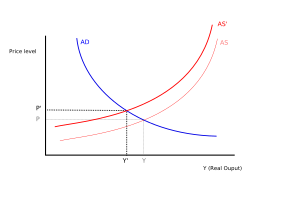Cost-push inflation
This article needs additional citations for verification. (July 2010) (Learn how and when to remove this template message) |

Cost-push inflation is a type of inflation caused by substantial increases in the cost of important goods or services where no suitable alternative is available. Higher prices are then the result, as costs of production increases due to a decreased aggregate supply. It stands in contrast to demand-pull inflation. Both accounts of inflation have at various times been put forward with oftentimes inconclusive evidence as to which explanation is superior.[1] A situation that has been often cited of this was the oil crisis of the 1970s, which some economists see as a major cause of the inflation experienced in the Western world in that decade. It is argued that this inflation resulted from increases in the cost of petroleum imposed by the member states of OPEC. Since petroleum is so important to industrialized economies, a large increase in its price can lead to the increase in the price of most products, raising the price level. Some economists argue that such a change in the price level can raise the inflation rate over longer periods, due to adaptive expectations and the price/wage spiral, so that a supply shock can have persistent effects.[2]
See also[edit]
References[edit]
- ^ Samuelson, Paul A.; Solow, Robert M. (1960). "Analytical Aspects of Anti-Inflation Policy". 50 (2): 177–194. Cite journal requires
|journal=(help) - ^ Kenton, Will. "Cost-Push Inflation". Investopedia. Retrieved 2019-02-25.

No comments:
Post a Comment